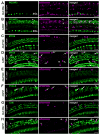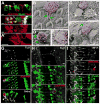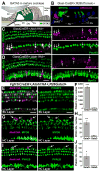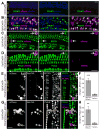In Vivo Interplay between p27Kip1, GATA3, ATOH1, and POU4F3 Converts Non-sensory Cells to Hair Cells in Adult Mice
- PMID: 28402854
- PMCID: PMC5423718
- DOI: 10.1016/j.celrep.2017.03.044
In Vivo Interplay between p27Kip1, GATA3, ATOH1, and POU4F3 Converts Non-sensory Cells to Hair Cells in Adult Mice
Abstract
Hearing loss is widespread and persistent because mature mammalian auditory hair cells (HCs) are nonregenerative. In mice, the ability to regenerate HCs from surrounding supporting cells (SCs) declines abruptly after postnatal maturation. We find that combining p27Kip1 deletion with ectopic ATOH1 expression surmounts this age-related decline, leading to conversion of SCs to HCs in mature mouse cochleae and after noise damage. p27Kip1 deletion, independent of canonical effects on Rb-family proteins, upregulated GATA3, a co-factor for ATOH1 that is lost from SCs with age. Co-activation of GATA3 or POU4F3 and ATOH1 promoted conversion of SCs to HCs in adult mice. Activation of POU4F3 alone also converted mature SCs to HCs in vivo. These data illuminate a genetic pathway that initiates auditory HC regeneration and suggest p27Kip1, GATA3, and POU4F3 as additional therapeutic targets for ATOH1-mediated HC regeneration.
Keywords: aging; cancer; cochlea; development; differentiation; hearing; proliferation; regeneration; sensory.
Copyright © 2017 The Author(s). Published by Elsevier Inc. All rights reserved.
Figures






Similar articles
-
Generation of mature and functional hair cells by co-expression of Gfi1, Pou4f3, and Atoh1 in the postnatal mouse cochlea.Cell Rep. 2021 Apr 20;35(3):109016. doi: 10.1016/j.celrep.2021.109016. Cell Rep. 2021. PMID: 33882317
-
In vivo generation of immature inner hair cells in neonatal mouse cochleae by ectopic Atoh1 expression.PLoS One. 2014 Feb 20;9(2):e89377. doi: 10.1371/journal.pone.0089377. eCollection 2014. PLoS One. 2014. PMID: 24586731 Free PMC article.
-
Co-overexpression of Atoh1, Pou4f3, and Gfi1 enhances the transdifferentiation of supporting cells into hair cells in the neonatal mouse utricle.Neurosci Lett. 2025 Feb 16;849:138136. doi: 10.1016/j.neulet.2025.138136. Epub 2025 Jan 28. Neurosci Lett. 2025. PMID: 39884380
-
Atoh1 and other related key regulators in the development of auditory sensory epithelium in the mammalian inner ear: function and interplay.Dev Biol. 2019 Feb 15;446(2):133-141. doi: 10.1016/j.ydbio.2018.12.025. Epub 2018 Dec 31. Dev Biol. 2019. PMID: 30605626 Review.
-
Atoh1 in sensory hair cell development: constraints and cofactors.Semin Cell Dev Biol. 2017 May;65:60-68. doi: 10.1016/j.semcdb.2016.10.003. Epub 2016 Oct 14. Semin Cell Dev Biol. 2017. PMID: 27751776 Review.
Cited by
-
Three distinct Atoh1 enhancers cooperate for sound receptor hair cell development.Proc Natl Acad Sci U S A. 2022 Aug 9;119(32):e2119850119. doi: 10.1073/pnas.2119850119. Epub 2022 Aug 4. Proc Natl Acad Sci U S A. 2022. PMID: 35925886 Free PMC article.
-
TUB and ZNF532 Promote the Atoh1-Mediated Hair Cell Regeneration in Mouse Cochleae.Front Cell Neurosci. 2021 Nov 8;15:759223. doi: 10.3389/fncel.2021.759223. eCollection 2021. Front Cell Neurosci. 2021. PMID: 34819838 Free PMC article.
-
Dynamic patterns of YAP1 expression and cellular localization in the developing and injured utricle.Sci Rep. 2021 Jan 25;11(1):2140. doi: 10.1038/s41598-020-77775-8. Sci Rep. 2021. PMID: 33495483 Free PMC article.
-
Hearing restoration through hair cell regeneration: A review of recent advancements and current limitations.Hear Res. 2025 Jun;461:109256. doi: 10.1016/j.heares.2025.109256. Epub 2025 Mar 22. Hear Res. 2025. PMID: 40157114 Review.
-
Research progress on flat epithelium of the inner ear.Physiol Res. 2020 Nov 16;69(5):775-785. doi: 10.33549/physiolres.934447. Epub 2020 Sep 9. Physiol Res. 2020. PMID: 32901490 Free PMC article. Review.
References
-
- Blackwell DL, Lucas JW, Clarke TC. Summary health statistics for U.S. adults: national health interview survey, 2012. Vital Health Stat. 2014;10:1–161. - PubMed
-
- Chen P, Segil N. p27(Kip1) links cell proliferation to morphogenesis in the developing organ of Corti. Development. 1999;126:1581–1590. - PubMed
Publication types
MeSH terms
Substances
Grants and funding
LinkOut - more resources
Full Text Sources
Other Literature Sources
Molecular Biology Databases
Miscellaneous

